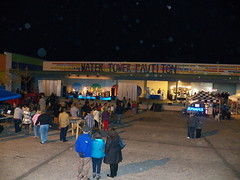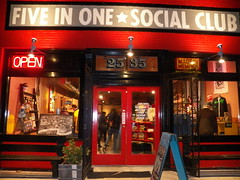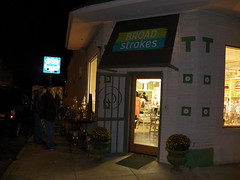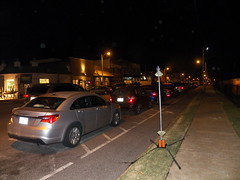










































Not that many years ago, Broad Street (as we called it then) was largely vacant, except for a bar or two and the venerable Broadway Pizza Company. It had once been the downtown of a separate town called Binghampton, but in 1915, Binghampton voted to give up its separate identity and become part of the city of Memphis. Not long afterwards,a city ordinance changed Broad Street to Broad Avenue, because Memphis had determined that all east-west streets must be avenues and all north-south streets would be streets. (This ordinance also tripped up the legendary “Beale Street”, and getting Beale back to “street” status took almost 30 years). But the remarkable transformation of the Broad Avenue area to Memphis’ second arts district has only taken about two years, and periodically now the district celebrates its new boom with Friday night art walks, similar to the Trolley Nights in the other South Main Arts District. On Friday, November 7, a large crowd was in the Water Tower Pavilion, listening to a great band of students from the School of Rock performing on the stage, with food trucks and clothing vendors nearby. Up on Broad, crowds were making their way to the different galleries and shops, new restaurants like Bounty on Broad, and temporary exhibits highlighting local products like Relevant Coffee Roasters, and some of the best handmade caramel candies I have ever eaten. Broad Avenue is definitely worth a visit as the Christmas season approaches, for unique gifts that cannot be found elsewhere.
Redevelopment
The Forgotten Legacy of Chero-Cola
Architecture, Food, History, Redevelopment
One of the cooler things about building renovations is that sometimes they uncover pieces of history, such as old plaques or advertising signs. Such was the case with the building being converted into residences next to the Webster Avenue Stage in Memphis’ River Arts Fest. I had been standing beside it for a couple of hours or so, and hadn’t noticed anything about it, but when the afternoon sun hit it a certain way, I could clearly make out an old sign: “Chero-Cola Bottling Company.” What on earth was Chero-Cola, I wondered? As it turns out, Chero-Cola, founded by a grocery store owner in Columbus, Georgia in 1915 was the predecessor to the far better-known Royal Crown Cola, or RC, the beverage that went with a moon pie in the Southern past. The founder was trying to find a replacement for Atlanta-based Coca Cola when the Columbus distributor for the latter refused to give him a volume discount he felt he deserved. Although the first Royal Crown beverages appeared earlier (a ginger ale and a root beer), Chero-Cola (did it perhaps include cherry flavoring in the formula?) first appeared in 1915, and only lasted through about 1921, when a court ruled that the designation “cola” could only be used by Chero-Cola’s famous competitor, Coke. Without being able to designate their signature drink as a cola, sales flagged, and the company was renamed from Chero-Cola to Nehi. By the time it introduced a new cola formula in 1933, the name had been changed again to Royal Crown or RC. A court in 1944 overturned the old 1921 decision, and RC’s became officially “colas” again. But the coolest thing is that the relatively-short time that Chero-Cola existed helps us place the Memphis building in time between the years 1915 and 1921. A really cool discovery indeed!
Bringing Light to Prichard’s Alabama Village
Community Organizing, Redevelopment, videosIn Prichard, Alabama, where there never seems an end to bad news, the neighborhood called Alabama Village is frequently the subject of really bad news- shootings, murders, stabbings, arsons, as well as boarded-up houses and widespread abandonment. But a few years ago, a bold group of Christians called Light of the Village decided to move into a former crack house and try to bring hope to a place that often seems truly hopeless. On the video above, Light of the Village director John Eads discusses the origins and challenges of his organization’s ministry with Colton Bradford. Visit the Light of the Village website to learn more, donate, or volunteer to this most worthwhile goal.